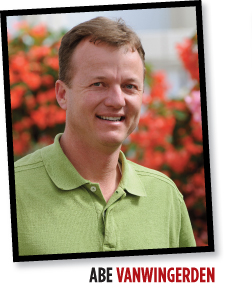5/1/2019
It’s a “Process,” Not a “Project”
Abe VanWingerden

(Editor’s note: For the first time ever, Abe got caught by the pressures of spring and had to miss a column deadline. Instead, here is a timely “best of” from the archives.—CB)
In our roles as managers, we ultimately get asked to wear many hats each day and too many times, due to being pulled in so many directions, we take a business problem and we quickly come to a solution. But the issue is that many times we take the easy path of moving the problem out of the way rather than eliminating it. Bottom line: We treat every situation like a “project” rather than a “process.”
Here are a few examples I’ve seen just in the last three months as we headed into the spring season:
R&D—Research and Development isn’t something we can do when “things slow down.” First, things don’t slow down anymore like they used to. The only way to find more time for research and development is to invest in it and staff a person/department whose sole purpose is to test new ideas, validate current ideas and eliminate bad ideas we continue to do every day.
An example of this is item selection/development. Many of us travel to Spring Trials and that becomes our R&D trip for the year, as we talk to breeders at the trials, compare notes from the previous season and then make selections. Instead, we have to test items all year long, visiting and being visited by breeders all year long, and going to other greenhouses/gardens to see what’s working and not working. Late March/early April isn’t the only time we should be in R&D mode. Innovation is a process, not a project.
Training Programs—We should all have training programs for our employees. The problem many of us face is that we normally do this once a year in one- to two-hour sessions, and the development stops there. We saw this in action at Metrolina for the last few years with regards to safety. We were on a negative upswing when it came to workplace OSHA recordable injuries. Our solution was to implement a one-hour, safety-training seminar for current employees. While this worked in reducing the incidents for a couple of months, inherently, the incident rate popped back up again.
After some investigation, we found the reason was that new employees were 10% of the mix of employees, but more than 50% of the incidents. We should have had safety training for new employees right when they came on rather than once a year in a one-hour session. We hired a safety director and assured “on-the-job” training, as well as posting proper safety procedures throughout the facility and many other safety processes to make them part of daily work rather than a meeting employees attended once a year. And, naturally, in just two short years, we’ve reduced our OSHA recordable injuries by more than 50%. Training is a process, not a project.
Technology—Technology is one area we’ve all invested tons of dollars in over the last five years. The frustrating thing for many of us is that we’ve invested significant capital investment into technology, but we’re not always seeing the payout. We have to realize the technology is merely a tool that can make your people better and more efficient, but if we don’t enable our people to use the tools to their fullest capability, then the investment payout isn’t there.
We’ve seen examples of this during our ERP implementation the last three years. While we were spending significant capital in purchasing the system we’re using, we still had people with “shadow systems” to work around the new tools. Only after a couple of months did we realize we had to cut out the old “work-arounds” to assure our people were using the new tool to make themselves better and more efficient. It had to be part of their daily work, not in addition to their current roles. Technology is a process, not a project.
Just “checking the box” is easy in each of these areas, but the success that comes from innovative R&D, great training and cool technology starts with a dedication to the work on a daily basis. GT
Abe VanWingerden spent eight years working for Procter & Gamble in Sales and Marketing and is now part owner and President of Sales/Marketing at Metrolina Greenhouses, Huntersville, North Carolina.